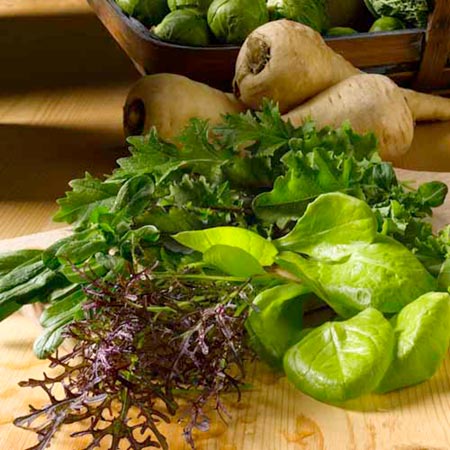
Winter salad
Many people grow their own salad in the summer, but strangely winter salads have never quite taken off in the same way.
The good news is that the growing methods used are very similar and that, with a few small adjustments, you can grow tasty salads in the garden all year round.
Choose from hardy varieties of your favourite summer lettuce, or experiment with more unusual winter salad crops such as Texsel greens and salad burnet. For a continuous supply, sow a few seeds every four weeks.
Good drainage is essential for growing winter salad as the seedlings will simply freeze if left standing in pools of water. Choose a sheltered, sunny position when deciding where to grow your salad as it’s important that the seedlings are protected from cold winter winds.
What to do
Soil preparation
- Choose a sheltered sunny spot in the garden and prepare the soil by digging over and mixing in well-rotted manure or garden compost. This will add nutrients and help the soil retain moisture.
- Rake to leave a fine finish.
- Alternatively prepare a container mix of potting compost and John Innes and use a window box or pot.
How to sow
- Sow between late August and mid-November. Regular sowings will ensure that you have a good continuous crop.
- Sow seeds in short, shallow rows. Cover with soil, label and water.
- If a sharp dip in temperature is predicted (particularly overnight), consider covering your seeds with a cloche or fleece to protect them.
Aftercare
- Keep soil just moist but ensure that your seedlings do not get too cold or wet. This is particularly important for winter salad, so keep an eye on the weather forecast and protect your seedlings if a frost is predicted.
Harvesting
- Harvest leaves from cut-and-come again lettuces when plants are about 5cm (2in) high, or allow the plants to grow to about 15cm and cut the whole head off leaving a 3cm (1in) stump – a new plant should soon re-sprout.
Growing tips
- Winter salads traditionally have a strong, robust flavour that can sometimes be a little bitter. If you find that your salad leaves are too bitter for your tastes, try blanching the leaves by covering the plants with an upturned flowerpot.
- Left like this for a few days before harvesting, the leaves will become paler and less bitter.
Ten winter salad plants to try
This list is a combination of the most hardy ‘summer’ lettuces, and salad leaves which are specifically at their best in winter. Try growing a few of each for a variety of tastes.
- Lettuce ‘Artic King’ – this large ‘butterhead’ lettuce is light green, crunchy and exceptionally hardy. Sow by mid September for best results, or later under glass.
- Lettuce ‘Valdor’ – this dark green lettuce has a tight core of leaves and is very hardy. Sow in September and October for picking 10-12 weeks later.
- Texsel Greens – also known as Ethiopian greens, this fast-growing salad plant can be sown until the end of October, or later under glass. The leaves taste similar to spinach and can be used in the same way.
- Radicchio ‘Treviso Precoce Mesola’ – an autumn sowing of these seed will produce deep maroon leaves without any trace of the bitterness often associated with radicchio.
- Endive ‘CanCan’ – a frisee-type of lettuce which is tough enough to survive the winter outside in milder areas or under some protection in cooler climates.
- Winter Purslane – hardy, green and tasty, sow the seed of this salad leaf in August and September for salad throughout the winter
- ‘Golden Purslane’ – the more glamorous relative of regular winter purslane. The red stems of ‘Golden Purslane’ look wonderful against the golden leaves and will brighten up a salad bowl.
- Salad Burnet – The leaves of this perennial have a cucumber flavour and are good in salads. Harvest frequently for a steady supply of tender leaves.
- Corn salad – also known as lamb’s lettuce. This salad leaf grows slowly, so plant the seeds as early as possible
- Land cress – an excellent substitute for watercress, this plant can be picked around eight weeks after sowing. It’s not entirely frost-resistant though, so cover the plants with a cloche or fleecing if the temperature drops.

